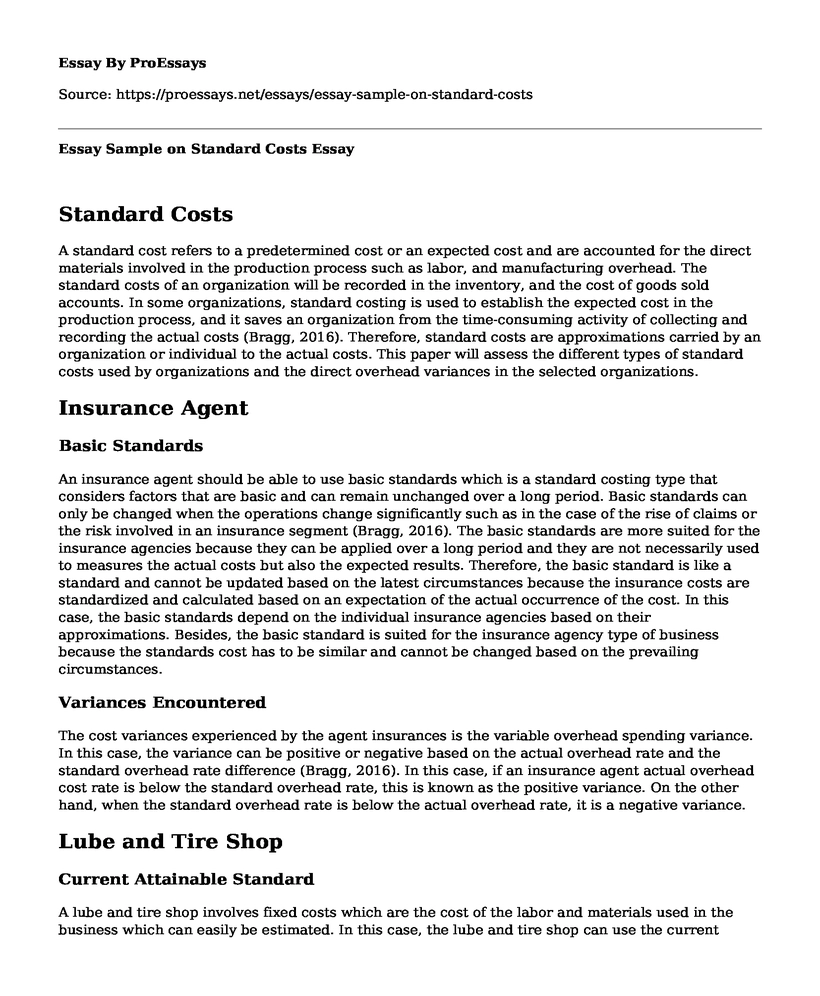Standard Costs
A standard cost refers to a predetermined cost or an expected cost and are accounted for the direct materials involved in the production process such as labor, and manufacturing overhead. The standard costs of an organization will be recorded in the inventory, and the cost of goods sold accounts. In some organizations, standard costing is used to establish the expected cost in the production process, and it saves an organization from the time-consuming activity of collecting and recording the actual costs (Bragg, 2016). Therefore, standard costs are approximations carried by an organization or individual to the actual costs. This paper will assess the different types of standard costs used by organizations and the direct overhead variances in the selected organizations.
Insurance Agent
Basic Standards
An insurance agent should be able to use basic standards which is a standard costing type that considers factors that are basic and can remain unchanged over a long period. Basic standards can only be changed when the operations change significantly such as in the case of the rise of claims or the risk involved in an insurance segment (Bragg, 2016). The basic standards are more suited for the insurance agencies because they can be applied over a long period and they are not necessarily used to measures the actual costs but also the expected results. Therefore, the basic standard is like a standard and cannot be updated based on the latest circumstances because the insurance costs are standardized and calculated based on an expectation of the actual occurrence of the cost. In this case, the basic standards depend on the individual insurance agencies based on their approximations. Besides, the basic standard is suited for the insurance agency type of business because the standards cost has to be similar and cannot be changed based on the prevailing circumstances.
Variances Encountered
The cost variances experienced by the agent insurances is the variable overhead spending variance. In this case, the variance can be positive or negative based on the actual overhead rate and the standard overhead rate difference (Bragg, 2016). In this case, if an insurance agent actual overhead cost rate is below the standard overhead rate, this is known as the positive variance. On the other hand, when the standard overhead rate is below the actual overhead rate, it is a negative variance.
Lube and Tire Shop
Current Attainable Standard
A lube and tire shop involves fixed costs which are the cost of the labor and materials used in the business which can easily be estimated. In this case, the lube and tire shop can use the current attainable type of standards costs. The current attainable standard fits the business profile because the cost of the products used in the business can change over time based on the market factors of demand and supply (Berger, 2011). Besides, the currently attainable standards take into considerations the cost of normal spoilage, the cost of idle time due to repair machine breakdown and any other unavoidable event. Besides, the current attainable standards can be revised occasionally to meet the changes in prices.
Variance Encountered
The lube and tire shop experiences the fixed overhead spending variance because the overheads can be fixed based on the inventory. In this case, if the actual fixed overhead is more than the budgeted overhead the business will incur a negative variance, and when the budgeted fixed costs less than the actual fixed overhead the business will experience positive variance (Berger, 2011).
References
Berger, A. (2011). Standard Costing, Variance Analysis, and Decision-Making: Management accounting and control. Munchen: GRIN Verl.
Bragg, S. M. (2016). Cost accounting fundamentals: Essential concepts and examples. Fifth Edition. 2016 Print
Cite this page
Essay Sample on Standard Costs. (2022, Oct 28). Retrieved from https://proessays.net/essays/essay-sample-on-standard-costs
If you are the original author of this essay and no longer wish to have it published on the ProEssays website, please click below to request its removal:
- Accounting Information for Financial Management - Essay Example
- Essay Sample on Double Entry Accounting
- Empowering Employees to Achieve Company Goals - Essay Sample
- The Global Economic World: A Look at Globalization - Essay Sample
- Essay Example on Creating an Equitable Payment Plan: Dessler's Five-Step Process
- Investing in Employee Training: Benefits vs. Challenges - Essay Sample
- Essay Example on Venezuela: Boom-and-Bust Journey of an Oil-Rich Nation







